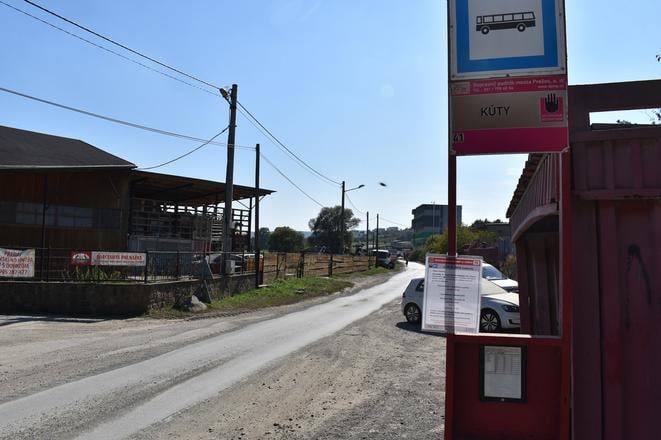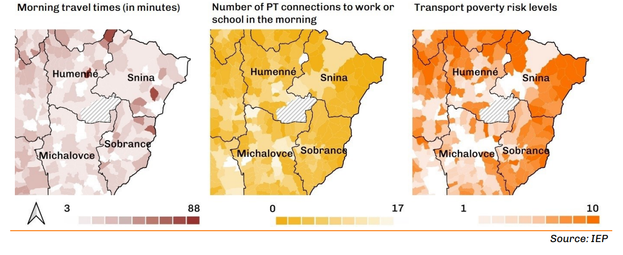In Slovakia, hundreds of villages have buses that run only two or three times a day. Commuting to work or school can be exhausting due to frequent stops, and sometimes the nearest bus stop is several kilometres away.
Many households rely on cars, but not everyone can afford one, which particularly affects the elderly and low-income residents.
According to the Institute for Environmental Policy at the Environment Ministry, people in these villages suffer from "transport poverty." This is often due to low bus frequency or excessively long travel times.
For instance, in Studienka (Malacky district), around 20 percent of residents (about 340 people) commute to Bratislava. In the morning, only four bus services are available, with the journey taking 75 minutes – twice as long as the same trip by car.
A new study from the institute also considers households transport-poor if they lack a car, cannot afford fuel or tickets, or have a bus stop that is too far away.
In Stráne pod Tatrami (Kežmarok district), the nearest stop is a 20-minute walk from a Roma settlement of over 1,900 people, most of whom do not own cars. Limited transport access further deepens their social exclusion.
Measuring transport poverty
Analysts have assigned each Slovak village a Transport Poverty Index on a scale of 1 to 10, with 10 indicating the highest risk.
According to the index, 76,000 people live in villages rated at level 10. A score of 8 or higher is already problematic, affecting 363,000 residents.
The most affected regions include Gemer, Upper Zemplín and northern Šariš, with nearly half of all villages in Prešov and Banská Bystrica Regions classified as high-risk.
Local perspectives
Despite these findings, some mayors claim there are no complaints. In Lomnička (3,500 residents), Prešov Region, buses run only three times a day to the nearby town of Podolínec, where passengers must transfer.
“No one has complained,” said Mayor Mária Oračková. "People have cars or walk to Podolínec – it’s only three kilometres," she explained.
Other mayors echoed this sentiment, saying residents have adapted. “I understand that a bus carrying only two or three people is unprofitable,” said Ladislav Ladomirjak, mayor of Zboj, a remote village in the north-east corner of Slovakia.
However, those without cars face significant challenges. Marta (name changed), a Zboj resident, travels to Snina (40 km away) about twice a month. The bus ride takes 80 minutes and includes 30 stops.
“If I need a blood test, I take the 05:40 bus to arrive before 07:30,” she said. “At least we still have buses – I just hope they won’t be cancelled,” she continues.
Rising fuel costs & future solutions
From 2027, the EU will extend its carbon trading system to transport, making petrol and diesel more expensive. Estimates suggest fuel costs could rise by €47–100 per year. This will hit car-dependent rural areas hardest.
To ease the impact, the EU has set up a €1.5-billion Social Climate Fund for Slovakia. The government must submit a spending plan by June.
Analysts recommend investing in electric buses, charging stations and subsidies for low-income travellers. They also propose discounts on fares, second-hand EV grants, cycle paths, and incentives for carpooling.
Currently, an electric bus costs 80 percent more than a diesel one, while a hydrogen bus is 150 percent more expensive. Without proper investment, transport poverty in Slovakia may only worsen.


 A bus stop in Kúty. (source: Korzár/Michal Frank)
A bus stop in Kúty. (source: Korzár/Michal Frank)
 Degrees of vulnerability of municipalities to transport poverty (source: IEP)
Degrees of vulnerability of municipalities to transport poverty (source: IEP)
 The impact of travel time and number of public passenger transport connections on the transport poverty risk level in the districts of Snina and Sobrance (source: IEP)
The impact of travel time and number of public passenger transport connections on the transport poverty risk level in the districts of Snina and Sobrance (source: IEP)
 The impact of age of vehicles, number of vehicles and unemployment rate on the transport poverty risk level in the districts of Rimavská Sobota and Revúca (source: IEP)
The impact of age of vehicles, number of vehicles and unemployment rate on the transport poverty risk level in the districts of Rimavská Sobota and Revúca (source: IEP)